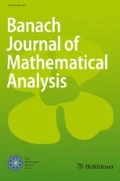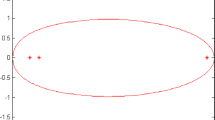Abstract
In this paper, the numerical range of an even-order tensor is defined using the norm of its square matrix unfolding. The basic properties of the numerical range of a matrix, such as compactness and convexity, are proved to hold for the numerical range of an even-order tensor. Also, we introduce normal tensors based on the contraction product. According to the Tucker decomposition, we get the numerical range of a normal tensor. Next, we introduce the singular-value decomposition (SVD) of an even-order tensor. Using this decomposition, we obtain the numerical range of such a tensor.
Similar content being viewed by others
References
Bloy, L., Verma, R.: On computing the underlying fiber directions from the diffusion orientation distribution function. In: Medical Image Computing and Computer Assisted Intervention MICCAI 2008, pp. 1–8. Springer, Berlin (2008)
Bonsall, F.F., Duncan, J.: Numerical Range II. London Math. Soc. Lect. Notes Ser. Cambridge University Press, New York (1973)
Brazell, M., Li, N., Navasca, C., Tamon, C.: Solving multilinear systems via tensor inversion. SIAM J. Matrix Anal. Appl. 34(2), 542–570 (2013)
Chang, K., Pearson, K., Zhang, T.: Perron–Frobenius theorem for nonnegative tensors. Commun. Math. Sci. 6, 507–520 (2008)
Chang, K., Qi, L., Zhang, T.: A survey in the spectral theory of nonnegative tensors. Numer. Linear Algebra Appl. 20, 891–912 (2013)
Cui, L.B., Chen, C., Li, W., Ng, M.K.: An eigenvalue problem for even order tensors with its applications. Linear Multilinear Algebra 64, 602–621 (2016)
Horn, R.A., Johnson, C.R.: Topics in Matrix Analysis. Cambridge University Press, Cambridge (1991)
Itskov, M.: On the theory of fourth-order tensors and their applications in computational mechanics. Comput. Methods Appl. Mech. Eng. 189, 419–438 (2000)
Ke, R., Li, W., Ng, M.K.: Numerical range of tensors, Hong Kong Baptist University, Hong Kong. Linear Algebra Appl. 508, 100–132 (2016)
Knows, J.: On the representation of the elasticity tensor for isotropic materials. J. Elast. 39, 175–180 (1995)
Kofidis, E., Philip, Regalia, A.: On the best rank-1 approximation of higher-order supersymmetric tensors. SIAM J. Matrix Anal. Appl. 23, 863–884 (2002)
Kolda, T.G., Bader, B.W.: Tensor decompositions and applications. SIAM Rev. 51, 455–500 (2009)
Kolda, T..G., Mayo, J..R.: Shifted power method for computing tensor eigenpairs. SIAM J. Matrix Anal. Appl. 32(4), 1095–1124 (2011)
Lathauwer, L., Moor, B., Vandewalle, J.: On the best rank-1 and rank-(R1, ..., RN ) approximation of higher-order tensors. SIAM J. Matrix Anal. Appl. 21, 1324–1342 (2000)
Li, W., Cui, L., Ng, M.: The perturbation bound for the Perron vector of a transition probability tensor. Numer. Linear Algebra Appl. 20, 985–1000 (2013)
Li, W., Ng, M.: On the limiting probability distribution of a transition probability tensor. Linear Multilinear Algebra 62, 362–385 (2014)
Lim, L.: Singular values and eigenvalues of tensors: a variational approach. In : Proceedings of the IEEE International Workshop on Computational Advances in Multi-Sensor Adaptive Processing (CAMSAP’ 05); Dec 13–15; Puerto Vallarta. pp. 129–132 (2005)
Liping, C., Lixing, H., Liangmin, Z.: Computing tensor eigenvalues via homotopy methods. SIAM J. Matrix Anal. Appl. 37(1), 290–319 (2016). (30 pages)
Lumer, G.: Semi-inner-product spaces. Trans. Am. Math. Soc. 100(1), 29–43 (1961)
Ng, M., Qi, L., Zhou, G.: Finding the largest eigenvalue of a nonnegative tensor. SIAM J. Matrix Anal. Appl. 31, 1090–1099 (2009)
Ni, Q., Qi, L., Wang, F.: An eigenvalue method for testing the positive definiteness of a multivariate form. IEEE Trans Autom. Control 53, 1096–1107 (2008)
Qi, L.: Eigenvalues of a real supersymmetric tensor. J. Symb. Comput. 40(6), 1302–1324 (2005)
Qi, L.: Eigenvalues and invariants of tensors. J. Math. Anal. Appl. 325, 1363–1377 (2007)
Qi, L.: Symmetric nonnegative tensors and copositive tensors. Linear Algebra Appl. 435, 228–238 (2014)
Qi, L.: Theory of Tensors. Department of Applied Mathematics, The Hong Kong Polytechnic University, Hong Kong (2014)
Qi, L., Luo, L.: Tensor Analysis: Spectral Theory and Special Tensors Paperback. SIAM, April 19 (2017)
Qi, L., Wang, F., Wang, Y.: Z-eigenvalue methods for a global polynomial optimization problem. Math. Program. 118, 301–316 (2009)
Qi, L., Wang, Y., Wu, E.: D-eigenvalues of diffusion kurtosis tensor. J. Comput. Appl. Math. 221, 150–157 (2008)
Qi, Yu, G., Wu, E.: Higher order positive semidefinite diffusion tensor imaging. SIAM J. Imaging Sci. 3, 416–433 (2010)
Ragnarsson, S., Van Loan, C.F.: Block tensors unfoldings. SIAM J. Matrix Anal. Appl. 33, 49–169 (2012)
Shashua, A., Hazan, T.: Non-negative tensor factorization with applications to statistics and computer vision. In: International Conference of Machine Learning (ICML), pp. 792–799 (2005)
Shen, S., Berger, T.: On the distribution formula of the eigenvalue of Teoplitz tensor and its application. Appl. Math. J. Chin. Univ. 2, 151–163 (1987)
Tarantola, A.: Elements for Physics: Quantities and Intrinsic Theories. Springer, Berlin (2005)
Yang, Q., Yang, Y.: Further results for Perron–Frobenius theorem for nonnegative tensors II. SIAM J. Matrix Anal. Appl. 30, 1236–1250 (2011)
Zhou, G., Qi, L., Wu, S.Y.: Efficient algorithms for computing the largest eigenvalue of a nonnegative tensor. Front. Math. China 8, 155–168 (2013). https://doi.org/10.1007/s11464-012-0268-4
Author information
Authors and Affiliations
Corresponding author
Additional information
Communicated by Fuad Kittaneh.
Rights and permissions
About this article
Cite this article
Pakmanesh, M., Afshin, H. Numerical ranges of even-order tensor. Banach J. Math. Anal. 15, 59 (2021). https://doi.org/10.1007/s43037-021-00142-w
Received:
Accepted:
Published:
DOI: https://doi.org/10.1007/s43037-021-00142-w



